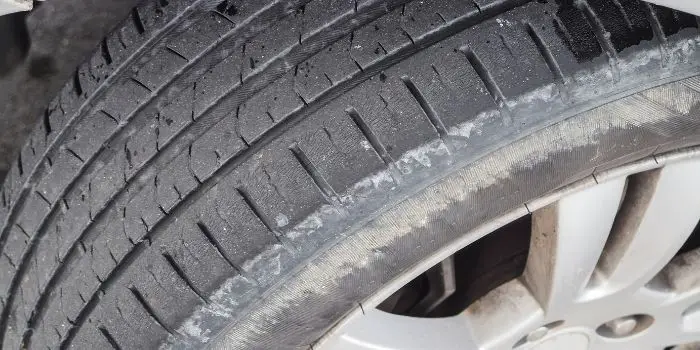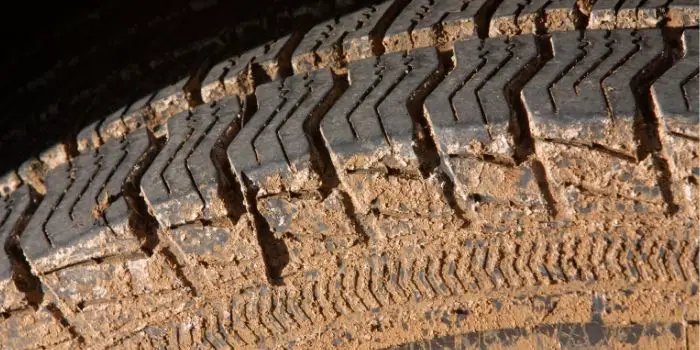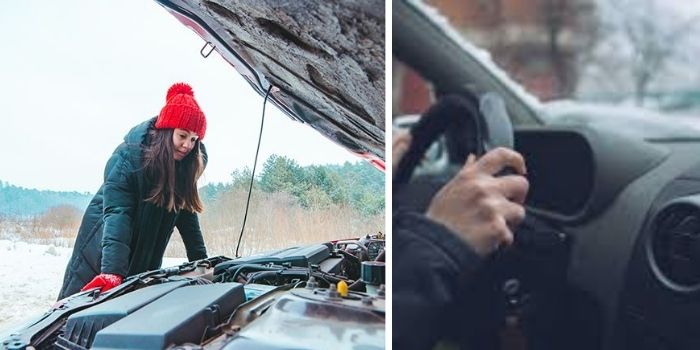You’re gazing at a dehydrated patch on your tire, wondering whether it would impair your car’s handling and control, not to mention your concerns about safety while driving, such as “will my tire burst as a result of these?”
While tiny cracks in your tires may be safe to drive with, you should consider taking action to remedy this problem as soon as possible since it may develop in size and cause more damage.
The ultimate remedy for rotted tires is clearly to get a new tire, but this is an expensive choice that is not always required, particularly if your tire tread is still decent.
With that being said, in this ultimate guide, you’re going to know everything you need to know about tire cracking, their causes, their fixings in a very detailed manner below.
Table of Contents
What is Dry Rot or Tire Cracking?
Cracked tires are visible cracks on the sidewall of a tire, also known as dry rot, that are produced by the breakdown of the rubber components.
Though the materials used to produce tires have gotten more durable and less costly over time as a result of advancements in technology and research.
These compounds are still subject to deterioration, which is often exhibited as visible fractures, as we shall discuss below.
Why do Car Tires Actually Crack?
Following are the several variables that interact with tires that cause damage and cracked tires:
1- Ultraviolet (UV) rays
The most dangerous enemy of tires is UV radiation seen in sunshine.
Extreme heat weakens polymer bonds by causing them to expand and shrink.
It is hard to safeguard your car all of the time, but parking it in the shade whenever feasible can help to prolong the life of the tires.
2- Age
Polymers inherently deteriorate with time, causing the tires to harden and lose elasticity. When the suppleness of a tire diminishes, it becomes brittle and prone to breaking.
You would imagine that the tires of an underused car that has been left in a garage for an extended length of time are safe from any wear, but this is not the case.
To keep the tires supple, they need heat and natural lubricant. It’s a good idea to go for a drive now and again.
3- Water
This is unusual since thick rubber is expected to be watertight.
Driving in rainy circumstances for an extended period might enable water to enter the rubber, which weakens the structure of the tires.
4- Tire Inflation
Tires that are underinflated have a bigger surface area in contact with the road. This raises the temperature and, as a result, the friction.
Over-inflated tires place undue strain on the tire’s sidewalls, resulting in bulging and cracking.
5- Manufacturing Error
Although uncommon, this does occur on occasion in newer vehicles.
If your car is still relatively new, you should take it back to the dealership for a professional examination.
6- Degradation
Rubber is natural since it is derived from trees. As a result, it will biodegrade over time; the process is irreversible.
Although protective chemicals and compounds are introduced during the manufacturing process, they too will wear away with time.
What are the Early Signs of a Rotted Tire?
The early warning symptoms listed below do not occur instantly. It takes time for the deterioration to become visible.
You won’t be able to determine whether they’re decaying right now if you check them.
One of the many reasons why preventive care is useful is that it may halt dry rot while it is still in the unseen stage.
Keep an eye out for the three signs listed below:
- Sidewall cracks in the tire
- Rubber is brittle and dry.
- Flaking or peeling on the surface.
Sidewall cracks in the tire
Cracks forming on your sidewall are an early warning sign of dry rot. You may see a few in one spot, or they may have completely encircled your hubcap.
Rubber is brittle and dry
Healthy rubber is flexible, which is why it is good for driving on. It accounts for changes in the road as well as the changing weight of your car.
When dry rot takes hold, the protecting waxes and oils begin to peel away. As a consequence, they will seem dried out and brittle to the touch.
Flaking or peeling on the surface
Small shards break off in strongly impacted places.
How to Fix Cracked Tires – Internally & Externally?
For the greatest efficacy, we recommend completing both inside and exterior repairs. A single approach will not be as effective.
Using Sealant to Repair Internally Cracked Tires
Sealants are a substance that is applied inside the tires. These are employed as precautionary measures or if a tire is already flat.
Pick one that describes dry rot or cracks particularly. Stop-flat variants are inappropriate and will not work.
Make certain that the brand of tire you pick is appropriate for you. Some, for example, are designed for bigger cars, and some are only suitable for lightweight vehicles.
What you’ll need:
- Crack sealant for tires.
- Pressure gauge of tire that is accurate and dependable.
- An air compressor.
Have you ever tried one of the given above? No?
Don’t be concerned; the procedure is not tough. That’s all there is to it:
- Allow your vehicle to cool down
- Take off stem valve
- Get the sealant ready
- Put the sealant
- Re-inflate the tire
- Drive
Step 1: Allow the vehicle to cool
Allow the car to cool down properly if you have driven it.
The tire you will be working on should be cool enough for you to touch easily.
Step 2: Get the Sealant Ready
It might have arrived as part of a package that included a hose.
Prepare the sealant according to the manufacturer’s instructions.
Step 3: Take off Stem Valve Cap and Put Sealant
Remove and set aside the cap of the stem valve.
To use the nozzle or the injector, insert it into the stem valve. Spray or squeeze in the quantity of sealant as specified.
Step 4: Inflate the Tire and Test Drive
While doing the fixing, you might have lost the air pressure.
Reinflate as required, using your pressure gauge to verify the PSI. The cap should be used to close the steam valve.
Next, take your vehicle for a spin to ensure that the substance covers the whole interior of a tire. Keep in mind that some sealants may not need this.
Externally Repairing Cracked Tires with Protectant
A sealant’s exterior counterpart is a protectant.
These coatings revitalize the rubber while also protecting it from hazards such as UV rays.
Pick a water-based sealant brand versus one that is solvent-based.
Because solvents are quite volatile substances, which means they may be dangerous if handled improperly.
Equipment Required:
- Glove
- Tire sealant
- Tire-friendly degreaser
- Large draining pan
- Jack stands and floor jack that work well
- Wrench for lugs
- A water source
- Clean clothes and a sponge
- Containers or jars that are empty
This fixing will take a bit longer than the interior tire repairing approach. So, allow around one and a half hours to complete the following steps:
- Create a proper work area and allow your vehicle to cool down
- Put your working gloves on and jack up the automobile
- Take out any cracked units and place the tire in the drain pan
- Apply the degreaser and allow it to settle for a few minutes before scrubbing
- Thoroughly rinse it, allow it to air-dry after wiping it down
- Remove the drain pan’s contents
- Use a protectant and refill
- Then repeat the process with all of the impacted units
And you’ll be able to fix cracked tires from the outside.
How Can You Prevent Dry Rot on Your Car Tires in Future?
Regular tire maintenance and care will keep your tires from breaking prematurely.
1- Inspections at Regular Intervals:
You should keep a close eye on overall circumstances on a regular basis on the tread and sidewalls of your tires, especially searching for any cracks, discoloration, bulges, wear, or other unnatural blemishes.
2- Parking in the shade for lengthy periods:
Excessive ultraviolet rays from sunlight are a significant cause of early sidewall degradation, especially in continuously warmer locations.
If your car will be exposed to severe heat and sunshine, it is best to park in more covered places.
If you want to store a vintage automobile or vehicle outdoors, covering the vehicle and tires will help keep UV rays at bay.
3- Cleaning and Protecting:
The most basic way is to use a washcloth and mild dish soap every month to keep the surface clean.
A water-based cleanser won’t hurt your tires by introducing extra chemicals.
After cleaning the tires with soap, just rinse them with water.
4- Avoid Harmful Chemicals and Products:
If you want to use additional tire protectants or cleaning products, check the product labels and be aware of what other chemicals will be present on your tire.
Avoid using any petroleum-based cleaning chemicals, since they may deteriorate the weathering agents in the rubber, leading to premature cracking.
5- Proper Tire Inflation:
One of the leading causes of tire failure is driving with underinflated tires.
Underinflated tires cause greater wear and tear on the tread, which creates excessive friction along with excessive heat and may cause severe cracking, component separation, or tire failure.
Tires should be inflated to the manufacturer’s suggested levels, and tire pressure should be checked weekly.
If your tires have cracking or sidewall weathering, it may be more difficult to keep them correctly inflated air may be leaking out from those worn parts.
To increase the lifespan of your tires, maintaining proper air pressure in them is mandatory.
6- Avoid Overloading:
Tires are custom-made to suit the vehicle, and each tire has a suggested load capacity, which is the vehicle’s actual weight plus any extra weight carried by the vehicle.
Adding weight over the load capacity is known as “overloading,” and it puts too much strain on the tires. This extra weight on your tires may cause serious cracking or tire failure.
Consult your owner’s handbook to discover more about your tire and vehicle load restrictions.
7- Extended Parking Care:
If your car is staying stationary for an extended length of time, the following measures should be taken:
- If feasible, store the car in such a way that as much weight as possible is removed from the tires (for example, jack stands).
- Don’t let the direct sunshine fall on your car.
- Cover the car to avoid harmful UV radiation on the surface.
- Keep the car and tires in a clean, dry place away from chemicals and extreme temperature changes.
8- Tire Storage:
If long-term storage of winter or summer tires is planned, correct procedures must be followed.
The best way to store tires is to keep them mounted on the wheels and store them above the ground on hooks threaded through the rims themselves.
You invest in your tires the same way you do in your car.
Follow the instructions for regular care and maintenance above to help reduce the chance of sidewall weathering in your tires.
If fractures or visible sidewall weathering indications occur fix them as soon as possible by following the instructions given above.
FAQs
What is the average lifespan of tires?
This is a difficult issue to answer since there are so many factors to consider, such as mileage, driving styles, and surroundings.
However, even if there is no indication of cracking or dry rot, it is usually assumed that 10-years is the cut-off date.
The thread chemicals have most likely expired and will no longer be effective.
Is it safe to drive with cracked tires?
The majority of the time, you only need to be worried when fractures are deep or widespread.
While little cracks may indicate that your tires are aging or that you have a problem with your habits and routines, they do not always indicate that it is time to replace the tires.
However, you must take cracking seriously, no matter how little.
This is because it might be connected to incorrect tire maintenance, and you can take action to slow the cracking down.
Is it possible to fix a cracked tire?
Yes, cracked tires can be fixed, but only for cosmetic reasons.
The problem may be hidden but not fixed. There are fillers to fix cracks in the sidewall of a tire on your own.
It’s something to think about if you think the cracks are ugly and are causing aesthetic damage.
However, it is critical to remember that it is merely for looks and will not cure the dry rot.
This process should also not be used on tires with notable cracks as it conceals dangerous warnings of the tires.
Is it necessary to replace the cracked tires?
When the cracking is severe, you should replace the tires.
If it’s located all over the tire’s surface and spreads deep into the surface, it’s a warning that the compound isn’t working properly, and changing them is important for your safety.
If the cracks are minor, you don’t need to replace the tires, but now is usually a good time to start thinking about a new set since the tires are nearing the end of their useful life.
The Bottomline
UV exposure and oxygen, as well as vehicle storage and operating conditions, are key contributors to tire deterioration.
Knowing what cracked tires are will help you keep your tires in good condition. The driver’s and passengers’ safety is of the utmost importance.
This is simply accomplished by detecting when a tire is beyond repair and must be replaced.
We hoped this ultimate guide solved all your queries regarding tire cracks.

Based in Orem (Utah) John Paterson graduated from Utah Valley University and has begun writing in 2009. He has a large wealth of experience in writing articles related to cars, automotive repair, wheels, cleaning/maintenance, and much more. He has also written instructional articles in a similar niche for a few online publications as well. Currently, he works as a mechanic in his personal garage shop where he loves serving his countrymen from his heart.







